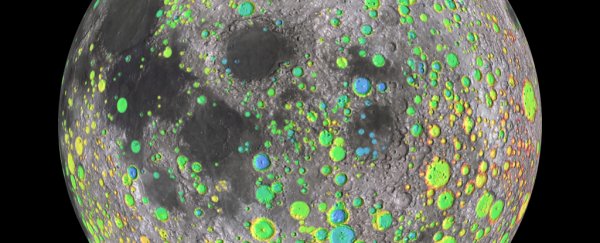If you look back far enough into Earth's hazy, long-forgotten prehistory, things get weird.
Like the battered face of the Moon, our own planet is covered in craters: a scarred legacy of millions of years of brutal, unforgiving asteroid impacts. What's weird, though, is once you look back about 300 million years, the evidence of this onslaught seems to almost disappear.
For a long time, scientists assumed the comparative rarity of impact craters dating back beyond 300 million years ago on Earth was linked to erosion; environmental processes like weather or tectonic activity had somehow wiped the slate clean, creating what's known as a 'preservation bias' in the scientific record.
Not so, according to a new study, which suggests an even simpler reason for the invisible asteroids.

It's not that our terrestrial record of asteroid impacts vanished after the fact. Rather, there just weren't as many asteroids hitting us – or the Moon, for that matter – way back when.
Ever since then, however, we've been caught up in an epic surge in asteroid activity, in which two to three times as many space rocks have rained down upon Earth and its trusty satellite.
"Our research provides evidence for a dramatic change in the rate of asteroid impacts on both Earth and the Moon that occurred around the end of the Paleozoic era," explains planetary scientist Sara Mazrouei from the University of Toronto, the first author of a new paper on the discovery.
"The implication is that since that time we have been in a period of relatively high rate of asteroid impacts that is 2.6 times higher than it was prior to 290 million years ago."
To reach this finding, Mazrouei and fellow researchers analysed data from NASA's Lunar Reconnaissance Orbiter (LRO), a space probe that's been orbitally surveilling the Moon for close to a decade.
One of the tools for this surveillance is called the Diviner – a thermal radiometer that can sense the heat of things on the lunar surface.

Because of this, it's able to effectively date the age of craters on the Moon, by measuring the heat of rocks that cluster around younger craters.
By the time craters get older, those larger rocks, called ejecta, have been ground down into a cooler, powdery moondust (due to a constant barrage of mini meteorites over a timescale of millions of years).
Thanks to the LRO, this newly observable difference between the two substances' powers of heat-trapping – known as thermal inertia – provides a way of measuring how old all those vast craters on the Moon actually are.
"A simple analogy for the concept of thermal inertia is rocks and sand at the beach," Mazrouei explains in The Conversation.
"During the day both large rocks and the sand are warm. However, as soon as the Sun sets, the sand gets cold. The large rocks which have a higher thermal inertia, however, stay warm for longer."
In their study, the team used this distinction to estimate the ages of 111 impact craters on the Moon younger than one billion years old.
What they found is that the vast majority of these giant pockmarks were produced in the last 290 million years – an incredible replication of the matching preponderance in Earth's last 300 million years or so (and the comparative non-existence of impacts before it).
"The Moon is like a time capsule, helping us understand the Earth," says one of the researchers, planetary scientist William Bottke from the Southwest Research Institute.
"We found that the Moon shared a similar bombardment history, which meant the answer to Earth's impact rate was staring everyone right in the face."
But if both Earth and the Moon started getting hit by a massive surge in local asteroids around 290 million years ago, what force unleashed this barrage?
Nobody really knows, but the researchers suggest a collision or breakup in the asteroid belt located between the orbits of Mars and Jupiter could have flung debris across space in our direction.
Such an event could produce "long-lived surges in the impact flux as the fragments are slowly driven to escape routes by nongravitational forces," the researchers explain in their paper.
"Asteroid evolution models suggest that the contribution of kilometre-sized impactors from a large parent-body disruption would have reached their new level within a few tens of millions of years of the breakup event(s), with the wave of bodies perhaps receding after hundreds of millions of years."
If that's true, we could be nearing the end of the surge phase. Or we could be right in the middle of the storm, or still at its outset – it's impossible to say for sure.
What does look likely, however, is that this surge helped shape the course of evolution (and extinction) on this planet, perhaps encompassing the Chicxulub event that helped wipe the dinosaurs off the face of the planet.
"It's perhaps fair to say it was a date with destiny for the dinosaurs," says one of the team, Earth scientist Thomas Gernon from the University of Southampton in the UK.
"Their downfall was somewhat inevitable given the surge of large space rocks colliding with Earth."
The findings are reported in Science.
